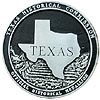| |
|
|
Dr. Charles Newton Gould |
|
 |
|
SH 136, about 40 mi. NE of Amarillo, Amarillo,
TX,
USA
Latitude & Longitude:
35° 33' 22.30782999984",
-101° 38' 44.6266100004"
|
| |
| |
|
Texas State
Historical Marker |
One of early scientists to use geology in search for oil and gas. This region's rapid economic growth in 1920s and '30s was result of Gould's selection of drill site for Hapgood No. 1--Masterson, discovery well of the vast Panhandle-Hugoton Gas Field, the world's largest known source for helium. Gould was born in Ohio; grew up in Kansas, where he began teaching; gained scientific background in summer schools and in covered wagon and horseback field trips; by 25 was a widely-known paleontologist; became a professor at the University of Oklahoma. In 1903-1905 he made studies of Texas Panhandle water resources, for the United States Geological Survey. A geological structure he observed (1904) and named Alibates Dolomite in 1907 led him to suggest to Amarillo merchants and ranchmen the drilling site in 1918 for Hapgood No. 1-Masterson Well. In 1919 he set the location for Gulf No. 2, first oil well in the Texas Panhandle and High Plains region. Gould was the scientist who first identified these quarries (now Alibates National Monument) as source for flint artifacts made by Ice Age Folsom Man--a major North American anthropological discovery.
This page last updated: 7/15/2008 |
Dr. Charles Newton Gould Historical Marker Location Map, Amarillo, Texas
|
|
|
|


